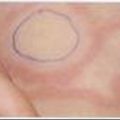7.8 Diarrhoea and vomiting
Examination
General observation
Note that the ABCD approach (airway, breathing, circulation, disability) is utilised.
Investigations
Not every child who is medically assessed requires investigations. The tests required depend on the possible differential diagnoses and the severity of illness (Table 7.8.1). Don’t forget simple bedside tests like urine analysis (UA) and blood glucose. This information can be invaluable in assessing the child with diarrhoea and vomiting. In this context, check the specific gravity and for ketones. Glycosuria may indicate diabetic ketoacidosis. If the UA is positive for nitrites or leucocytes, then an appropriately collected urine specimen should be cultured. The specimen to be cultured should be collected attempting to minimise contamination, even if re-collection is required.
AXR, abdominal X-ray; CXR, chest X-ray; RIA, radioimmunoassay.
Craig J.V., Lancaster G.A., Taylor S., et al. Infrared ear thermometry compared with rectal thermometry in children: a systematic review. Lancet. 2002;360(9333):603-609. [Review; 48 refs]
Craver R.D., Abermanis J.G. Dipstick only urinalysis screen for the pediatric emergency room. Paediatr Nephrol. 1998;11(3):331-333. [1998 erratum appears in Paediatr Nephrol 12(5): 426]
Gorelick M.H., Shaw K.N. Screening tests for urinary tract infection in children: a meta-analysis. Pediatrics. 1999;104(5):54.
Gorelick M.H., Shaw K.N., Baker M.D. Effect of ambient temperature on capillary refill in healthy children. Paediatrics. 1993;92(5):699-702.
Hewson P.H., Gollan R.A. A simple hospital triaging system for infants with acute illness. J Paediatr Child Health. 1995;31(1):29-32.
Neville K.A., Verge C.F., O’Meara M.W., Walker J.L. High antidiuretic hormone levels and hyponatremia in children with gastroenteritis. Pediatrics. 2005;116(6):1401-1407.
Neville K.A., Verge C.F., Rosenberg A.R., et al. Isotonic is better than hypotonic saline for intravenous rehydration of children with gastroenteritis: a prospective randomised study. Arch Dis Child. 2006;91(3):226-232.
Shaw K.N., McGowan K.L., Gorelick M.H., Schwartz J.S. Screening for urinary tract infection in infants in the ED: which test is best? Paediatrics. 1998;101(6):E1.









